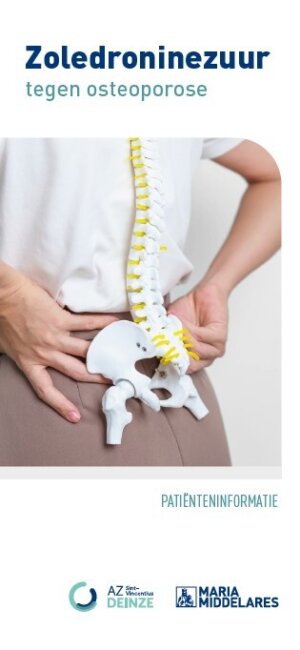Osteoporosis
Symptoms and causes
Symptoms and causesWhat is it?
Osteoporosis literally means'porous bone'. Both the quantity and quality of the bones decrease. Bone breakdown occurs too quickly, and the formation of replacement bone lags behind. This reduces bone strength , increasing the risk of fractures (bone breaks).
Causes and risk factors
- Increasing age
- Female gender
- Smoking
- Excessive alcohol consumption (more than 2-3 units per day)
- Genetic predisposition (e.g., a parent with osteoporosis or a history of hip fractures)
- Previous bone fracture after the age 50
- Prolonged bed rest or immobility, insufficient exercise
- Thyroid disorders (hypothyroidism)
- Diabetes
- Rheumatoid arthritis
- Body weight or BMI too low
- Long-term use of certain medications (e.g. corticosteroids)
- Early menopause
- Low levels of vitamin D in the bloodstream
Consequences
As mentioned above, the main consequence of osteoporosis is the significantly higher risk of fractures. Additionally, the risk of falling increases with age. In individuals, 1 in 3 women and 1 in 5 men over the age of 50 will suffer a fracture due to osteoporosis. Hip and wrist fractures are the most common fractures caused by falls. Vertebral collapses and fractures also occur regularly. These may even occur spontaneously.
Diagnosis and treatment
Diagnosis and treatmentDiagnosis
To diagnose osteoporosis, the physician will listen to your story and specifically ask about your history of falls and/or bone fractures. Additionally, a blood test will be performed, and X-rays may be taken if fractures are suspected. A bone density test (DEXA) also provides the physician with crucial information to diagnose osteoporosis and assess the risk of fractures.
Treatment
The treatment of osteoporosis involves a number of measures, the most important of which is to maintain or adopt a healthy lifestyle. Medication-based measures can also be taken.
A few tips:
- Keep moving: exercise strengthens muscles, balance, reactivity and bone formation. This reduces your risk of falls and fractures.
- Sunlight exposure: try to spend 15-30 minutes daily outdoors with your face and hands uncovered.
- Healthy eating:
- Calcium-rich diet (3 to 4 dairy products per day)
- Vitamin D (oily fish, egg yolks, spread and prepared fats)
- Limit alcohol consumption: no more than 3 alcoholic drinks per day.
- Quit smoking
- Fall prevention (read more about falls here)
- Vitamin D supplement (if calcium and vitamin D intake is too low)
- Medication for osteoporosis treatment
Your physician can determine the most appropriate medication for you. Ask for it!
Leaflet
LeafletOnly available in Dutch:

Zoledroninezuur
DownloadTreatment centres and specialisations
Treatment centres and specialisations
Latest publication date: 23/12/2024
Supervising author: Dr. Boer Mirra, Dr. Desimpelaere Patrick, Dr. Lambrecht Valérie
Something wrong or unclear on this page? Report it.
Supervising author: Dr. Boer Mirra, Dr. Desimpelaere Patrick, Dr. Lambrecht Valérie









